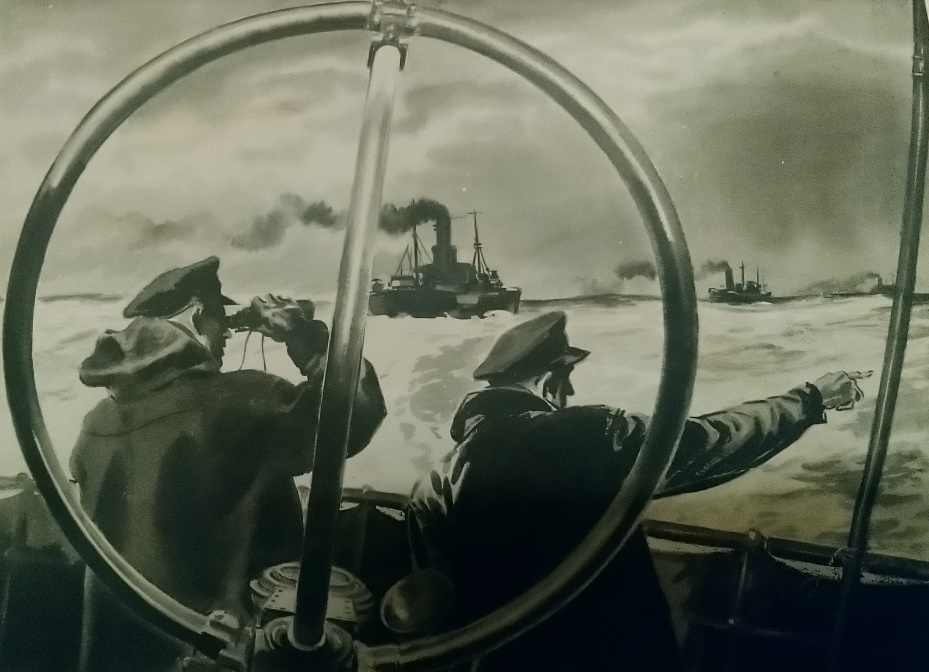Lewis Smith, the Essex Record Office’s Engagement Fellow, takes a look at some of the things in the Marconi Photographic Section’s archive.
Founded by Guigielmo Marconi in 1897, the Marconi Company (which held various names over its lifetime) were pioneers in wireless technology. Famously based in Chelmsford (regulars in the area will draw attention to places like ‘Marconi Road’ and ‘Navigation Road’), his technologies helped to shape the world we live in today: so much of our lives are a result of their research, from radio to navigation, from aeronautics to maritime, from communications continent to continent.

A11449 – 16748 MARCONI CO. TRADE MARK OR LOGO, 1947.
One part of the most interesting parts of the Marconi Company’s history was the Marconi Photographic Section, whom took hundreds of pictures over the organisation’s lifetime. These records are now stored at the Essex Record Office in Chelmsford. Unfortunately, this collection remains largely underused – so the British Society for the History of Science and Essex Record Office tasked me to spend some time scoping out the Marconi Photographic Section’s archive, working out what kind of images are within and, perhaps most importantly, work out how they can be used. Whilst I have only been in the archive for a relatively short period of time (since the beginning of October), there are some very interesting historical angles in desperate need of further research – from business to imperial history, from labour to marketing history.

A11449 – 78774, MAP OF NADGE RADAR CHAIN, 1968
One thing to note is that there are a lot of pictures of non-descript machines and circuitry – fans of the history of electronic engineering need look no further: historians of oscilloscopes, transmitters and receivers, power supplies, RADAR arrays, and pretty much all kinds of specialist electronic engineering will find something of interest here. These images present an extensive product history of Marconi’s inventions and patents. Perhaps more generally appealing, there is a lot for those interested in maritime and aeronautical history: one of the key ideas that came about from wireless communication was the idea of wireless navigation, and Marconi fitted many different pieces of equipment to aircraft and ships to aid in their navigation around the globe.

A11449 – 15771, TYPE D.F.G.26 RECEIVER WITH OSCILLOSCOPE TYPE O.R.3, 1945
But the view of higher international politics, engineering and industry are only one side of the coin: the prevalence of this technical equipment masks ordinary life. The archive presents us with a rich social history of the worker and their working practices. Workers, many male and female, black and white, British and international, are presented in the factories assembling intricate circuits. To look at the ethnography behind the people in these pictures reveals the clear shifts, both natural and forcible, in middle and working class employment. Notice particularly with image 2015 – everyone is happy and content, giving the viewer the impression that everything was okay working for Marconi. It wasn’t always this sweet.

A11449 – 2015, GIRLS WINDING & LACQUERING SHOP AT WORKS, 1919
As this is evidently the photographic archive of a business, there is huge scope for a business historian. These photographs are frozen moments in time, specifically captured because they want to show a particular angle, person, product or scene – why one moment and not another? Why one person over another? Why one place over another? More specifically, there are multiple photographs of how the Marconi Company attempted to market itself in a world of innovation: some of the most interesting pictures are of the exhibits set up to advertise wireless communication at various exhibitions.

A11449 – 2464, MARCONI STAND, AERO EXHIBITION, OLYMPIA, 1920
What is most interesting about the archive is the company’s vast spread throughout the globe: as with any history of the twentieth century, Empire remains front and centre. Imperial conquerors can come and go as they please, but radio technology meant the constant connection between colony and coloniser. Furthermore, the concept of technological Imperialism remained hot in this period: teaching others how to use Marconi equipment orients them towards using that equipment for a long time, forcing the colony to ask for technical help from the coloniser. This relationship is observable in the photographic archives as Marconi equipment was placed in different colonies, greatly expanding the imperial nation’s reach.

A11449 – 3070, MAHARAJAH USING A MARCONI TELEPHONE IN INDIA, No date.
Art lovers may also find something worthwhile in the archives. There are photographs of many different artistic drawings by members of staff in the collection depicting a variety of different scenes. The collection features many talented artists, as well as plastic models of Marconi scenes and vehicles, models of scientific principles, and copious drawings. It is easy to fall into the trap of thinking that science and art are two separate unconnected topics, but the collection features some stunning images which clearly appeal to the art behind science.

A11449 – 14559, PAINTING ENTITLED “VOICE OF FREEDOM”, 1943.
This collection is for use in the Essex Record Office under Accession A11449 in over 100 individual boxes. This project hopes to eventually digitise and map these images to show the company’s reach. I have spent time electronically tagging the pictures with keywords: if you would be interested in looking at this spreadsheet or further discussing the project, do contact me at lcsmit@essex.ac.uk. Whether for research or for a casual perusal, this collection really has a lot to offer!
